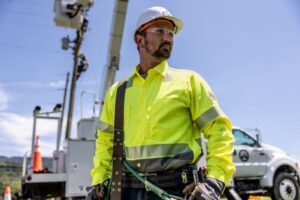Flame Resistant / Fire-Resistant / Flame Retardant
Not all FR gear is created equal.
At Feury Image Group, we help organizations build safer workplaces by managing uniform programs that meet regulatory standards, protect employees, and reflect a strong safety culture. But when it comes to flame protection, even experienced safety managers can be misled by the language on a label.
That’s why it’s important to understand the difference between flame-resistant, fire-resistant, and flame-retardant clothing—terms that sound similar but carry very different meanings when it comes to safety, durability, and compliance.
To help clarify the confusion, we’re sharing expert insight from Derek Sang, QSSP, IASHEP (CSHEP), an FR/AR safety educator with over two decades of experience advising companies on protective workwear.
Flame-Resistant (FR) Apparel: The Industry Standard
Flame-resistant (FR) clothing is engineered to resist ignition and to self-extinguish quickly if exposed to flame or high heat. It’s the standard for workers in industries such as utilities, energy, chemical manufacturing, transportation, and heavy industry.
FR garments come in two main types:
- Inherently flame-resistant fabrics are made from fibers with built-in protective properties.
- Treated FR fabrics start as flammable materials but are chemically treated to meet safety standards.
“Flame resistance is a performance characteristic, not just a label,” explains Derek Sang. “It’s the term recognized by OSHA, NFPA, and ASTM when referring to compliant garments.”
Fire-Resistant: Common, But Vague
While “fire-resistant” is often used to describe clothing, it’s a broader, less precise term. You’ll find it more frequently used for building materials (e.g., fire-rated drywall or doors) or consumer products.
“Fire-resistant isn’t necessarily incorrect,” says Sang, “but it’s not specific enough when referring to garments. In programs where you’re specifying apparel for Personal Protective Equipment (PPE), the word to trust is flame resistant.”
When it comes to outfitting workers, precision matters. Mislabeling or misinterpreting product descriptions could lead to regulatory noncompliance or increased risk in the field.
Flame Retardant: A Chemical Treatment, Not a Guarantee
“Flame retardant” refers to chemical additives or treatments used to make flammable materials more resistant to ignition. These treatments can be applied to everything from upholstery to curtains, and occasionally to apparel.
But here’s the issue: flame-retardant treatments can wear off with washing, time, or exposure—and in many cases, they don’t offer the same level of protection as certified FR garments.
“Flame retardant describes the process, not the performance,” Sang warns. “If you’re responsible for PPE, that distinction can make all the difference.”
Our Role in Safety-Focused Apparel Programs
At Feury Image Group, we develop custom uniform and apparel programs designed around your operational risks and compliance needs. From healthcare and transportation to manufacturing and energy, we help businesses:
- Choose appropriate FR and arc-rated (AR) garments based on hazard assessments
- Avoid misleading language or out-of-spec garments that put workers at risk
- Manage inventory and sizing across departments or multi-site teams
- Align branding and safety—so your company looks and operates professionally
With no rental contracts or unnecessary markups, our programs are built for flexibility, traceability, and cost control—without sacrificing quality or safety.
Why This Language Matters
Whether you’re managing a utility crew or a production line, choosing the wrong terminology—or the wrong clothing—can lead to:
- Noncompliance with OSHA or NFPA standards
- Increased injury risk in the event of a flash fire or arc blast
- Brand exposure and legal liability in the case of a preventable accident
That’s why we encourage safety officers, operations managers, and procurement teams to review every label and spec sheet with care—and partner with experts who do the same.
We Can Build a Safer, Smarter Uniform Program Together
Feury Image Group is here to help you reduce risk, ensure compliance, and create a professional look your team can take pride in.


